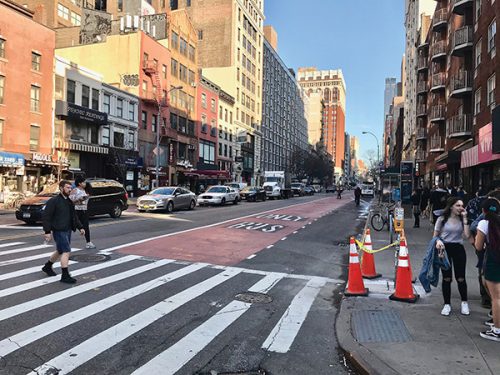By Brian J. Pape, AIA, LEED-AP

Greenwich Village and Chelsea block associations have begun organized action in February, forming the new 14th Street Coalition. They join with many other groups across Manhattan to prevent impending blows to the quality of life in their downtown areas and streets. Led by David Marcus, Gary Tomei, Judy Pesin, and Julianne Bond, dozens of people met to provide criticisms and calls for action against what they call “flawed” plans by the Metropolitan Transportation Authority (MTA) and the New York City Department of Transportation (DOT) to respond to the Canarsie L Train Shutdown from April 2019 to July 2020. (They are making repairs to the East River and 14th Street tunnels.) Street surfaces do not need to be disturbed for this.
WestView News contributor and Advocates for Justice attorney Arthur Z. Schwartz recently sent a letter to DOT Commissioner Trottenberg that the 14th Street Coalition is sharing with its email lists. The letter was also discussed at the coalition’s protest meeting on February 20th. In it, Schwartz calls for an Environmental Impact Statement due to the permanent environmental impact of the plan on vast swaths of the area. He also cites the many block associations and community groups that have joined forces against this plan. (See Schwartz’s article “14th Street Traffic Plan: It’s Not Being Handled Lawfully” on page 4 of this issue, which contains a copy of his letter.)
The first page of the MTA website, which includes the Canarsie L Train Shutdown (MTA.info), claims that input from over 40 community meetings yielded these most frequent comments:
- Buses need dedicated lanes.
- Provide multiple options, including ferry and simple, direct inter-borough bus routing, connecting to subways.
- Bike lanes should be physically separated.
- Street treatments should take emergency vehicle and delivery access needs into consideration.
- Manhattan residents fear traffic spillover on narrow, mostly residential side streets.
- Balance the needs of riders, residents, and businesses.
The MTA recognizes this input, yet it is alarming to see what they propose as follow-up. Here is how I see the mash-up.
- 14th Street has almost identical conditions as 23rd Street. A Select Bus Service (SBS) route on 23rd Street from 12th Avenue to Avenue C has been tested. Why try to reinvent the wheel? The MTA says that the standard SBS bus lane design was eliminated because it does not accommodate additional pedestrian space on the busiest blocks of 14th Street. However, no evidence has shown that significant increases (of up to twice that expected) will actually occur. More likely, the heavy pedestrian volumes on 14th Street under current conditions will decrease during the L Train Shutdown, allowing existing sidewalks to handle the load.
- The MTA is offering thoughtful transportation options to riders on subways, ferries, and buses, which is a good start. But the DOT is also proposing an untested mess of lane and traffic restrictions that must be stopped.
- Bike lanes that violate the design and safety standards of the city is STUPID and unsafe. Two-way lanes on one-way streets must be eliminated. They should only occur at pedestrian areas of parks as separate bikeways, not on city streets. Although bicycle use is growing, when the MTA says bicycle volumes are expected to increase 200% to 400% during the L Train Shutdown, that seems wildly optimistic. And why don’t they show bike lanes on 14th Street? As I rode recently on the 23rd Street bus lanes (without separate bike lanes), the lack of traffic made me feel quite safe. When delivery and ride-share vehicles block dedicated bike lanes, bikers are accustomed to merging briefly into traffic lanes. No big deal.
- Emergency vehicle and delivery access, as well as access to garages for residents, taxis and for-hire vehicles, can be accommodated by keeping lanes for vehicles, rather than turning them over for pedestrians only.
- Traffic spillover to side streets happens everywhere, and can only be controlled by the enforcement of ‘No Trucks’ restrictions and other rules. When garbage, delivery, or even bus vehicles temporarily block our side streets, common sense tells us to go a different route, or wait a few moments until they move again. Side streets already have some accommodations for parking and bikes without creating safety hazards.
- Balance the needs of riders, residents, and businesses by listening to their concerns and following their suggestions. An informal survey of area businesses says they are not aware of the plans. We need to all get involved and have our voices heard. Join the 14th Street Coalition.
Brian J. Pape is an architectural consultant in private practice. He serves as Co-chair of the American Institute of Architects New York Design for Aging Committee and as WestView’s Architectural Editor. Pape is also an officer of the health consultancy firm EnJOY Life!


